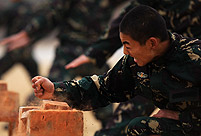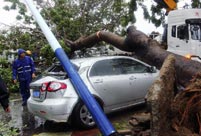People in affected populations are asked to be agents of change
The Joint United Nations Programme on HIV/AIDS warned of high HIV prevalence in key populations in Asia and the Pacific such as intravenous drug users and men who have sex with men, according to the organization's latest regional report.
However, the report said most intervention programs that focus on the high-risk groups are inadequate in size and scale. The report, titled HIV in Asia and the Pacific: Getting to Zero, was released in Bangkok on Tuesday at the 2013 International Congress on AIDS in Asia and the Pacific.
"The pace of progress needs to be redoubled to sustain past achievements, and efforts should be more focused on smart investments in the right places and on programs to reach the people in greatest need," said Steven Kraus, UNAIDS director of the regional support team for Asia and the Pacific.
According to the report, issued every two years, an estimated 4.9 million people were living with HIV/AIDS in the region in 2012. Twelve countries account for more than 90 percent of the infected population, including Cambodia, China, India and Thailand.
The recommendation comes despite a 26 percent decrease in new infections in the region since 2001, and many countries, having reduced new infections by at least 50 percent thanks to strengthened intervention and treatment, it said.
However, challenges also exist at the "pivotal juncture", with the overall number of new infections in the region remaining largely unchanged in the past five years.
Notably, the fastest growing epidemics in the region involve men having sex with men, and the HIV prevalence of the group could be more than 10 percent in at least 10 metropolitan areas in the region, it said.
The situation in China is tough as well, said Wu Zunyou, director of the National Center for AIDS and Sexually Transmitted Disease Control and Prevention.
China has an estimated 780,000 people with HIV/AIDS and only 56 percent of them are aware of their status, according to the National Health and Family Planning Commission.
In 2012, nearly 20 percent of newly detected cases were related to gay sex, a huge increase over the 2.5 percent rate in 2006.
Kraus said that people living with HIV and those in high-risk populations must continue to be central to the region’s AIDS response as agents of change.
Wu said that China would step up efforts to address the fast-growing epidemic among the vulnerable groups, mainly by further scaling up HIV testing and treatment.
He also said that more targeted efforts would be directed at youths. "Students ages 15 to 24 are increasingly at high risk of HIV/AIDS and the population of men having sex with men is being hit most," he said.
In 2012, nearly 74 percent of the students with HIV/AIDS in this age group were infected via gay sex, he added.
Mechai Viravaidya, chairman of the anti-AIDS NGO Mechai Viravaidya Foundation in Thailand said raising awareness was important, and joint efforts were needed among all stakeholders, including the vulnerable groups themselves.
 Luxury-cars parade held in Dubai
Luxury-cars parade held in Dubai Special forces take tough training sessions
Special forces take tough training sessions Fire guts 22-storey Nigeria commercial building in Lagos
Fire guts 22-storey Nigeria commercial building in Lagos Singles Day:
Singles Day:  Temperature drops dramatically in Beijing
Temperature drops dramatically in Beijing Typhoon Haiyan hits south China's Hainan
Typhoon Haiyan hits south China's Hainan Top 10 celebrity moms in China
Top 10 celebrity moms in China Weekly Sports Photos:
Weekly Sports Photos: Gingko leaves turn brilliant golden yellow in Beijing
Gingko leaves turn brilliant golden yellow in Beijing Maritime counter-terrorism drill
Maritime counter-terrorism drill Love searching stories in cities
Love searching stories in cities Male belly dancer in women’s fitness club
Male belly dancer in women’s fitness club  15 best rivers for travelers in world
15 best rivers for travelers in world National Geographic Traveler Photo Contest
National Geographic Traveler Photo Contest Weekly Sports Photos
Weekly Sports PhotosDay|Week|Month